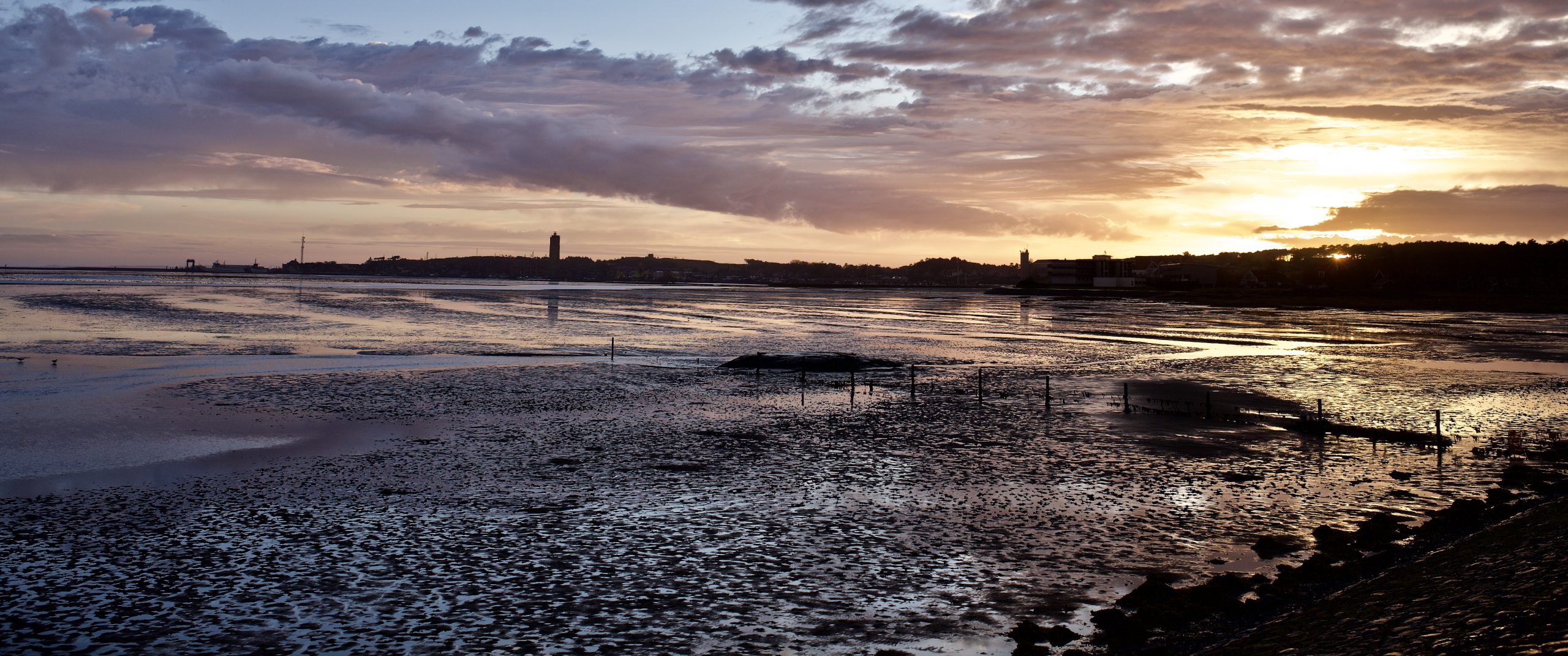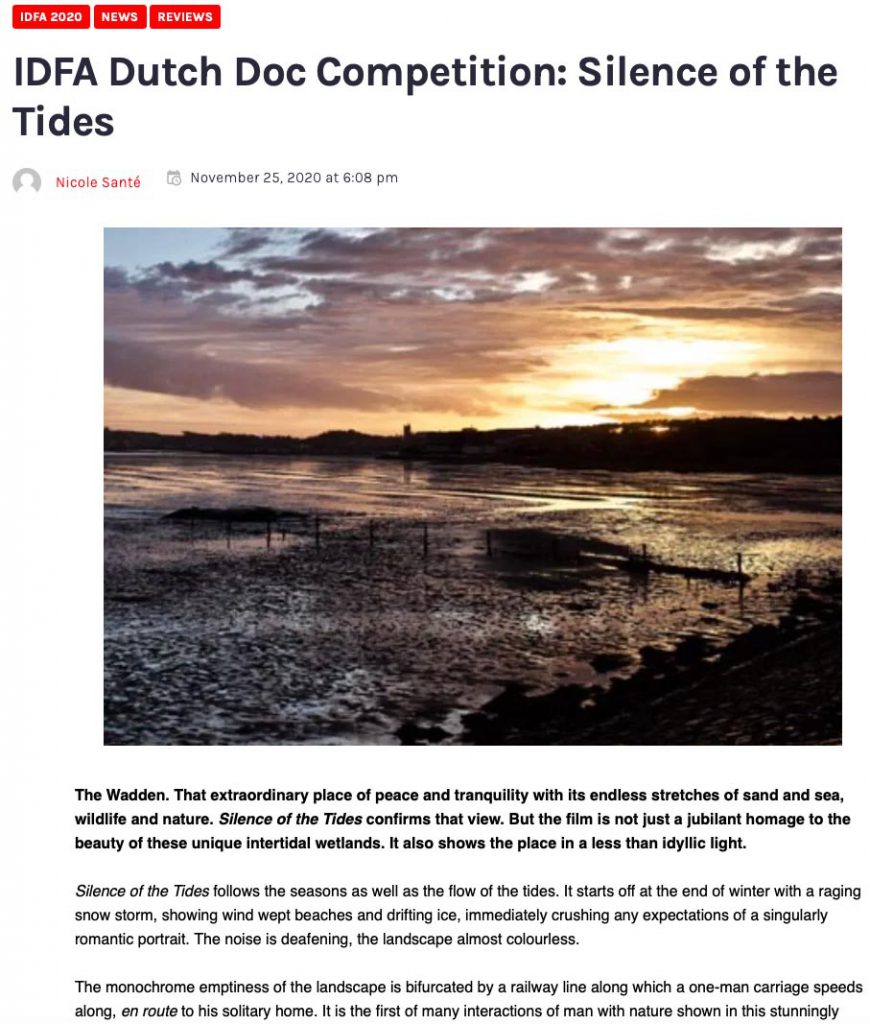

IDFA Dutch Doc Competition: Silence of the Tides
Datum: 25-11-2020 – Auteur: Nicole Santé
The Wadden. That extraordinary place of peace and tranquility with its endless stretches of sand and sea, wildlife and nature. Silence of the Tides confirms that view. But the film is not just a jubilant homage to the beauty of these unique intertidal wetlands. It also shows the place in a less than idyllic light.
Silence of the Tides follows the seasons as well as the flow of the tides. It starts off at the end of winter with a raging snow storm, showing wind wept beaches and drifting ice, immediately crushing any expectations of a singularly romantic portrait. The noise is deafening, the landscape almost colourless.
The monochrome emptiness of the landscape is bifurcated by a railway line along which a one-man carriage speeds along, en route to his solitary home. It is the first of many interactions of man with nature shown in this stunningly beautiful documentary. It paints the Wadden as an extraordinary biotope, created by the persuasive but unmistakably forceful power of the tides. The area extends along the coasts of the Netherlands, Germany and Denmark.
In the film, nature fills the mise-en-scène and provides the lighting for the breathtaking shots, in all kinds of weather and at different times of the day. We see the unforgettable wetlands at night time and the purple skies lit by the crescent moon as a solitary man wades through the shallow waters. It also provides the protagonists, the birds, the cows and sheep, and the human folk. The camera is pointed towards the sea, but it also dives in, making for mesmerizing shots of angelic jellyfish, crabs munching away on shrimps, camouflaged creatures capturing shellfish, starfish, pipefish and sea centipedes, all filmed in amazing colours and, without doubt, with vast reserves of patience.
As we follow the seasons, we become acquainted with the different animals, their habitats and their environment. We see how they mate, how they are born and raised, grow up and learn, survive or perish.
Throughout the year we see birds performing their sometimes elegant, sometimes quite uncouth mating rituals, such as the spoonbill hits the female with his long beak over the head! We see little lambs being born on the farm and eggs hatching in the wild. But you don’t want to get too attached to those fluffy hatchlings or the woolly ovines. Because the camera also registers the brutal attack of the seagulls on the spoonbills’ nursery, as well as the final journey of the lambs on their way to the slaughterhouse, where we witness their cold transformation into lifeless, furless cadavers, hanging in series from meat hooks.
Silence of the Tides is all but silent. Nature’s soundtrack is very much present, with the birdsong of numerous varieties, the naive bleating of lambs, the rolling of the waves, the rippling of the tides coming in and out. The makers added to this a carefully and artfully crafted score, making the sounds of spitting clams erotic, the crunching of creatures nibbling on their smaller victims almost tactile, the heartbeat of a newborn lamb palpable.
These sounds are loud but not as pervasive as the noise created by humans – the railway carriage, the big machines spouting sand, the enormous fishing boats emptying the seas, the jet fighters shooting through the air, the army machine guns firing blanks across the water. And then there’s the human sounds – the laughter, the screaming, the singing, the reading, but also the reassuring voice of a coastguard at the watchtower, confirming the movements of the ships and of the tides.
You cannot help but notice the devastating impact of humans on the fragile balance of nature. It seems people just can’t leave things alone – we always want something (sometimes too much) from nature. We want to breed and feed animals, observe and examine them, hunt and catch them, eat them, understand them. We thoughtlessly use the environment for fun and war games, destroying as we play and work.
But the incredible beauty of the Wadden also makes you consider our aesthetic response. Who else but us would be able to marvel at it? And create a documentary showing us the vulnerability and immeasurable importance of these natural sites. Silence of the Tides succeeds in raising our appreciation of nature while questioning our ambivalent relationship with it.
The Netherlands/Germany/Denmark.103 min
Director: Pieter-Rim de Kroon
Production: Annemiek van der Hell / Windmill Film
Executive Producer: Reinette van de Stadt for Windmill Film
Co-production: Bildersturm Filmproduktion GmbH, AVROTROS
Cinematography: Dick Harrewijn
Editing: Erik Disselhoff
Sound: Victor Dekker
Sound Design: Victor Dekker, Danny van Spreuwel, Lawrence Horne
Music: Birgit Wildeman
World Sales: The Party Film Sales

